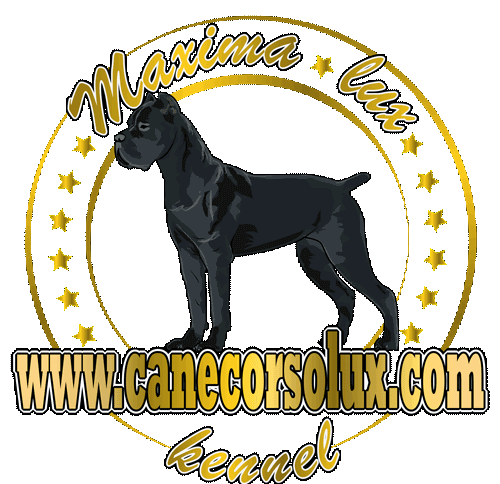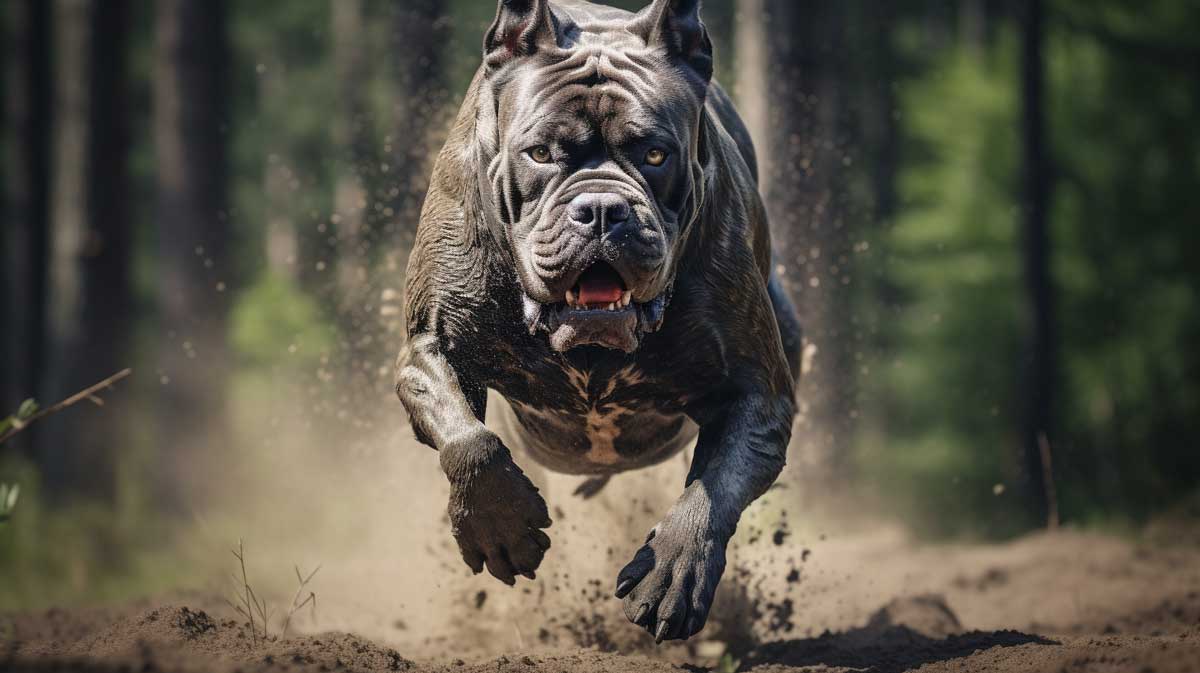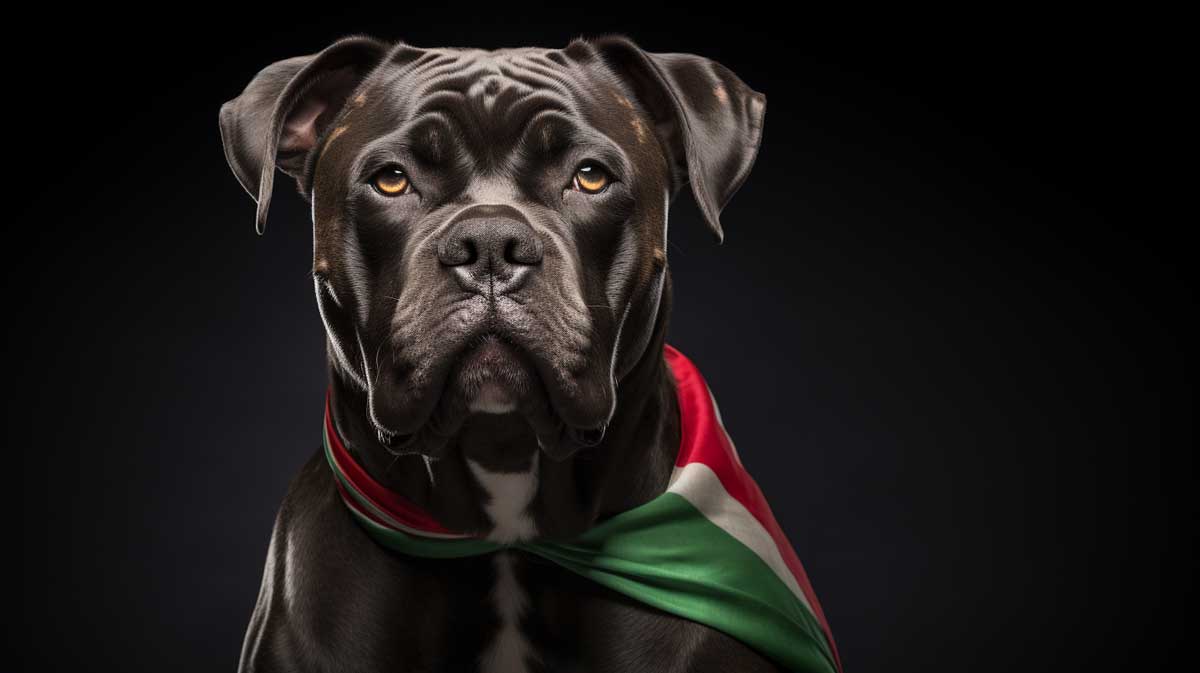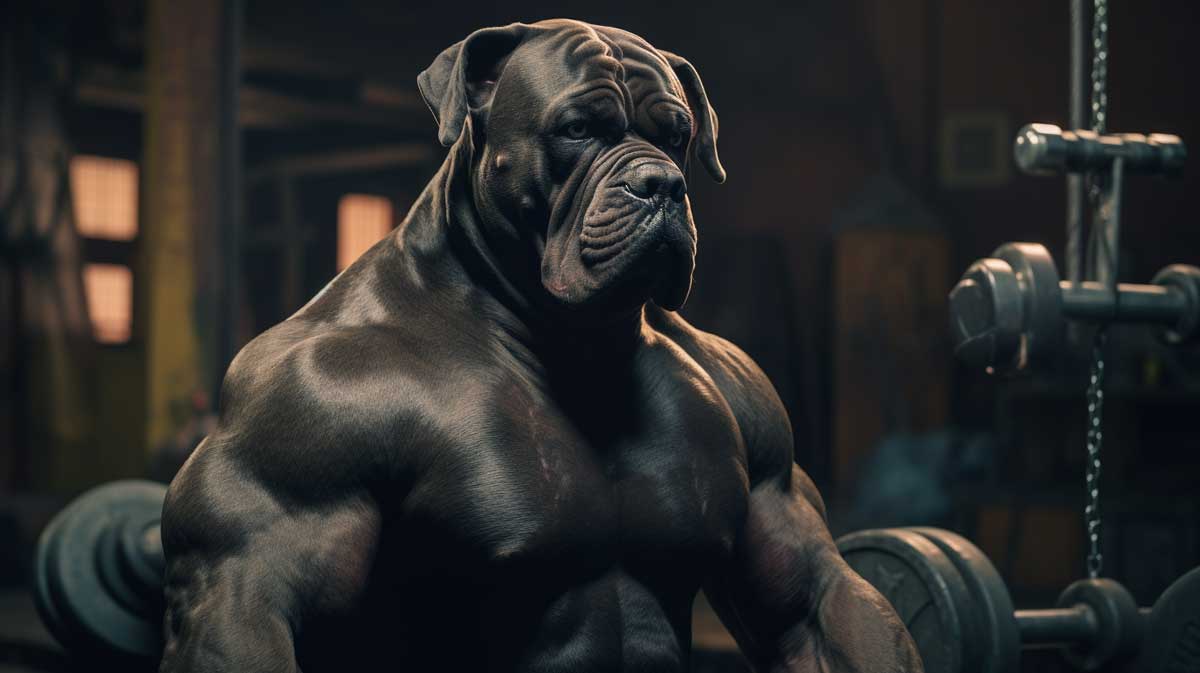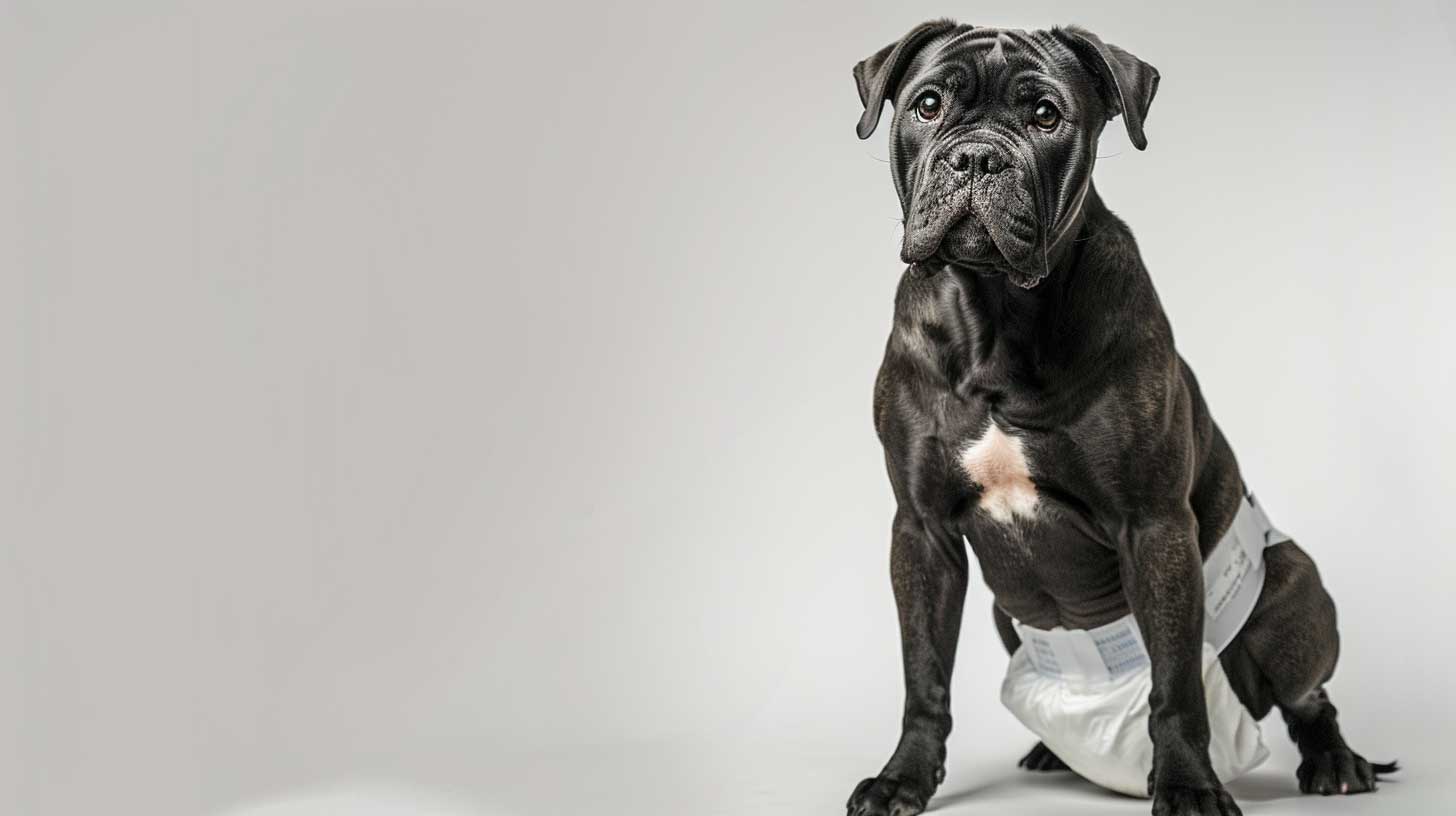The variety of colors in the coat of the cane corso requires an extended discussion.
At the beginning of the ‘80’s, when the breed’s recovery began, it was decided not to prefer any particular color but to consider all the tones that history and tradition had given us. Nevertheless, it turned out that the coat colours we found at the time were four: black, dark brindle, ash gray, and wheat (frumentino). As we have mentioned in earlier chapters, the dog’s color was often directly connected to his function, the geographic area in which he lived, and superstitions that considered this or that particular color tied to particular attributes. Actuals had been created of subjects with the same color and the same function.
A black coat was preferred by pig and goat breeders and was much used by cowboys. The black must be intense, bright but not shiny, and never tending to blue. White markings (on the toes and the chest but never large) are admitted, but total black is to be preferred. When the dog is in molt, the black may be in colour.
Dark brindles were chosen for wild boar hunts and were often used for herding. In the Cane Corso, the striping covers many gradations of red and is not always clearly delineated but can, in certain cases, fade into the base color, most especially in the darker brindles. This gives subjects that, due to the mixture of black and red hair, have three tonalities: for example, black, dark red, and light red, all in a mixture of unclear lines in which, however, the black must prevail. Brindles must always have a black mask.
The ashen coat was the favorite of cowboys and herders. Lead and late grey are occasionally brindled, but this is often found in the lighter shades, always with the red lines well-marked. In brindles with red lines, the mask is rarely present.
A wheaten colour (red with the tone of ripe grain) was preferred for badger and sometimes wild boar hunting, as well as by goatherds. There must always be a black or grey (perhaps the most typical) mask. This is black in the darker reds and grows lighter as the coat colour clears toward wheaten. It is important that the mask does not overreach the eye line (when it does, there is foreign blood in the subject), but the most typical is a gradual blending as it approaches that point.
A white band on the nose was much appreciated at the time.
Together with wheaten, the most typical colour was a light red with pearly tones.
We have said that in the past, there has been a study of longevity connected with a cane corso color; entires of the same colour were formed (dogs were rarely exchanged for mating). Modern breeding has instead given no particular preference to colour, and the result of the coupling of subjects of different coats has been a proliferation of different colours, particularly grey and red. We believe, however, that in the future, breeding should be oriented towards the four most common coats: black, dark brindle, ashen (even if brindled), and wheaten. In conclusion, we should remember that there are many white dogs immortalized in the iconography of the Cane Corso.
Like a vibrant tapestry woven with an assortment of hues, the world of Cane Corso colors is truly a sight to behold. From the sleek and sophisticated black coat to the warm and inviting fawn shade, these majestic dogs display an astonishing array of colors that captivate the eye.
But what lies beneath the surface? What genetic factors contribute to these stunning variations? And are there any colors that are deemed unacceptable in this remarkable breed?
Prepare to uncover the secrets behind the mesmerizing palette of Cane Corso colors as we explore the depths of their genetic makeup and unravel the mysteries of their coat variations.
Key Takeaways
- Gray color in Cane Corsos is determined by the presence of a recessive dd homozygote in combination with B- and K- alleles, resulting in a diluted black coat.
- Brindle Cane Corsos have dark stripes on their coat, typically found on the head, legs, and tail.
- Fawn Cane Corsos have yellow-colored coats resembling sand or parchment, which are the dilute black form.
- Choko and liver colors are not accepted in the standard for Cane Corsos, while black, gray, fawn, and red are recognized colors.
Black color
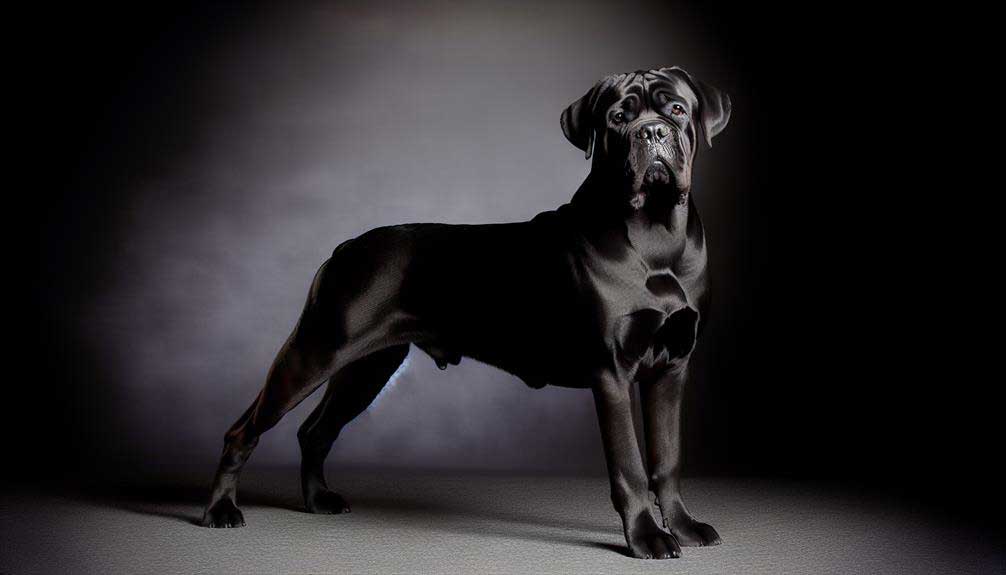
The black color is a frequently occurring and distinct variation in the Cane Corso breed, characterized by a rich pigmentation of melanin in the coat. Black corsos have a striking appearance with their dark coats and glowing brown eyes. Their coats may lack a dense undercoat, making them prone to having incorrect coats. However, their menacing look and strong presence make them ideal as watchdogs and personal protectors.
Breeders can selectively breed for specific coat colors by understanding the correlation between phenotype and genotype. This knowledge allows for innovative approaches to achieving desired coat colors in Cane Corso breeding programs.
Fawn Color
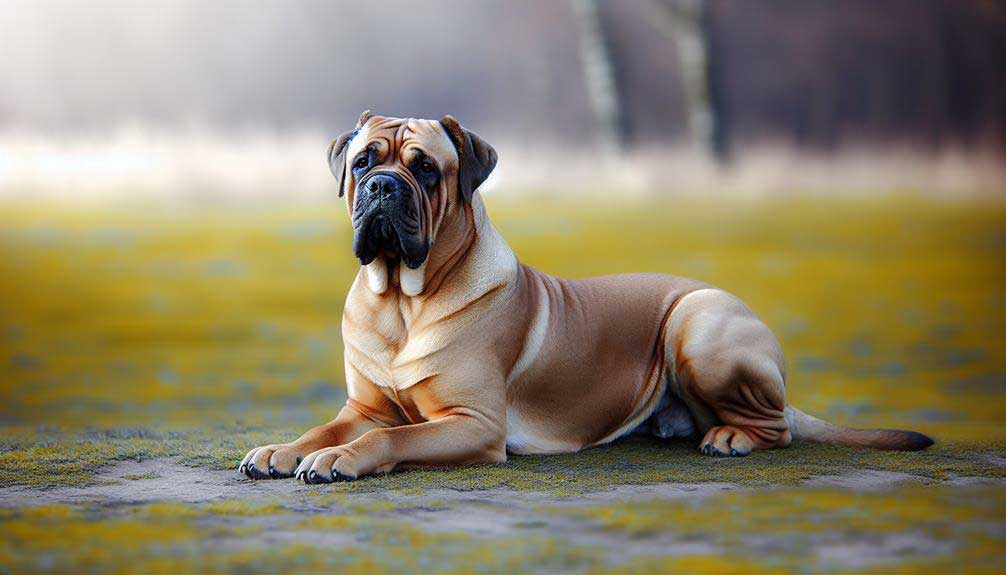
Fawn Corsos, known for their creamy-colored coats and rich undercoats, are a recognized color variation in the Cane Corso breed. The fawn coat genetics of these dogs contribute to their unique appearance. Fawn Corsos have been historically significant, as they’ve been used for hunting since the 3rd or 4th century. They’re prized for their ability to track blood and overall versatility as working dogs.
The variations of fawn color in Cane Corsos can range from light cream to red. The American Kennel Club (AKC) accepts any shade of fawn for show purposes. However, it’s important to note that a long or silky coat may affect their showing career, as the breed standard calls for a short and dense coat.
The dog’s mask must be black, not extended beyond the eyes.
Fawn color isn’t limited to cane corsos. It can also be found in other dog breeds such as Boxers, Great Danes, and Mastiffs. However, the fawn color is highly accepted and appreciated in the Cane Corso breed.
In dog shows, fawn Corsos are judged based on their adherence to the breed standard, which includes factors such as temperament, structure, and coat color. Fawn Corsos are evaluated on their overall appearance and how well they represent the breed’s characteristics.
Gray color
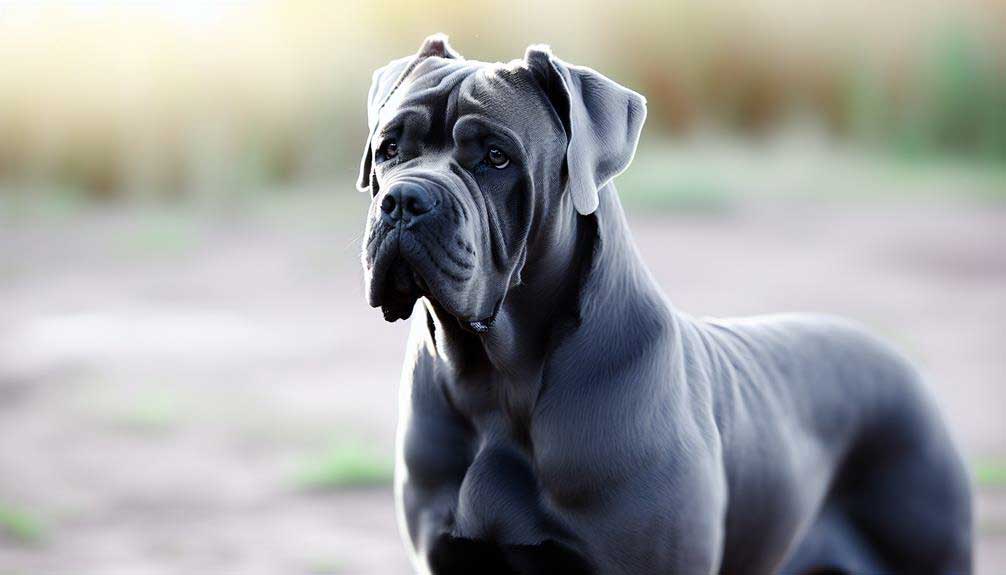
The genes that control the color of cane corsos are unique. A recessive DD homozygote combining with particular alleles is what causes it. The dd alleles, which diluted the black hair color to gray, are one of many genetic factors that affect the gray color in Cane Corsos.
Here are five key points to understand about gray Cane Corsos:
- Variations of gray in Cane Corsos can range from standard gray to slate gray and light gray. These shades of gray are significant as they add diversity and uniqueness to the breed.
- While the popularity of gray may not be as high as some other Cane Corso colors, gray Corsos are highly sought after by enthusiasts and breeders due to their distinctive appearance.
- Gray color plays an essential role in the breeding and showing of Cane Corsos. Breeders carefully select for the gray color genes to produce desirable gray puppies that meet the breed standards.
- Gray Cane Corsos possess specific traits and characteristics that make them excellent working and companion dogs. They’re known for their intelligence, loyalty, and protective instincts, making them ideal for various tasks.
- Gray Corsos require proper care and attention to maintain their coat’s color and health. Regular grooming and a balanced diet are essential to keep their gray coat looking its best.
Red color
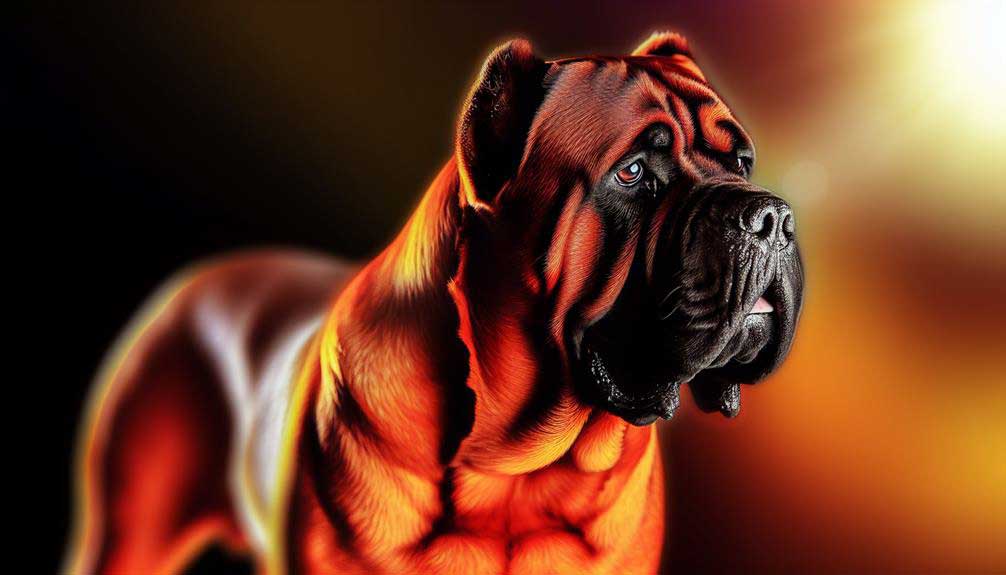
A black mask and the potential presence of a black or blue saddle mark (when the puppies are small) characterize the red color in Cane Corsos. The shades of red vary widely, ranging from a pale champagne to a rich mahogany. The genetic pathway determines the precise shade of the red coat by influencing the same pigment responsible for all shades of red in Corsos. Red Corsos, although less common than fawn Corsos, possess their unique appeal.
Regarding red color genetics, it’s important to understand that the red coat results from specific gene combinations. Breeding two red Corsos together can produce red puppies, but it’s essential to consider the genetic makeup of each parent to ensure the desired traits are passed down.
Red brindle variations are also possible in Cane Corsos. This occurs when the base color of red or brown is overlaid with black tiger stripes. The brindle pattern can vary widely from dog to dog, adding a distinct and striking appearance to the red coat.
Black brindle
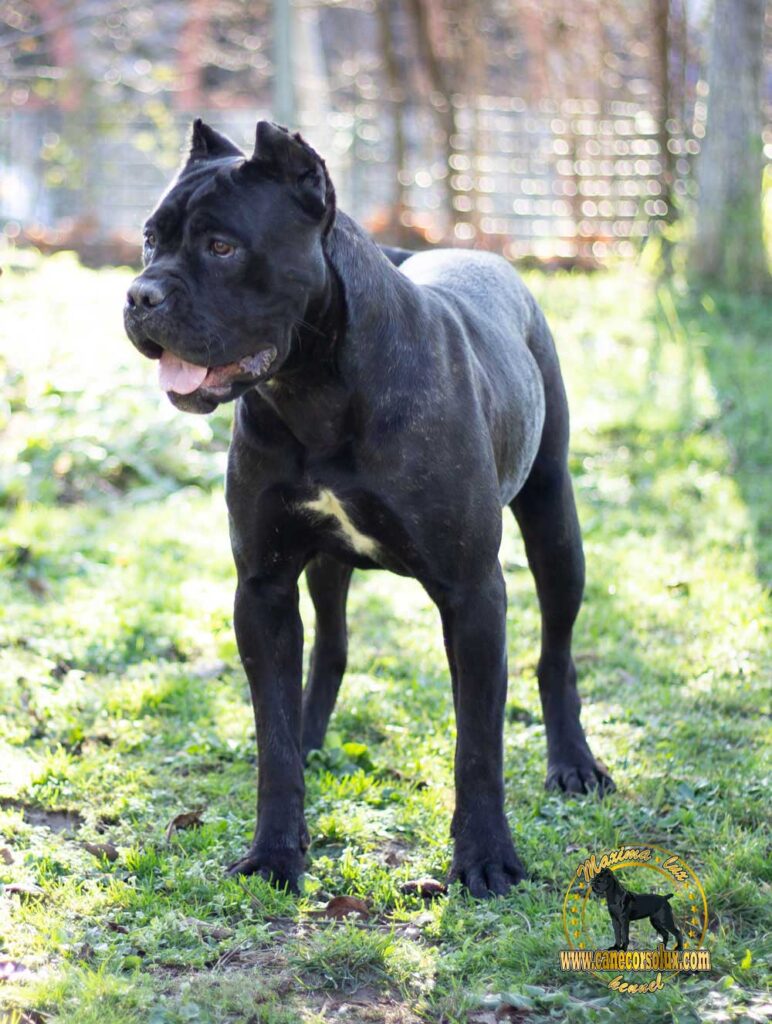
When considering coat variations in Cane Corsos, it’s important to explore the distinctive characteristics of the black brindle coloration. This unique pattern combines a base color of red or brown overlaid with black tiger stripes.
If there is an overwhelming light color, that color is called reverse black brindle.
Here are some key aspects to understand about black brindle Corsos:
- Black Brindle Genetics: The black brindle coloration is a normal variation in the breed and doesn’t indicate any genetic anomaly. It’s the result of specific genetic combinations that produce the striking black tiger stripes on a red or brown base color.
- Black Brindle Temperament: The coat color of black brindle Corsos has no bearing on their temperament. However, like all Cane Corsos, they’re known for their loyalty, protectiveness, and intelligence. Proper training and socialization are important for shaping their temperament.
- Black Brindle Coat Care: The care for a black brindle Cane Corso’s coat is similar to that of other colors. Regular grooming, including brushing and bathing, is necessary to keep their coat healthy and free from matting. Additionally, it’s important to protect their coat from sun damage by providing shade and using pet-safe sunscreen.
- Black Brindle Breed History: Black brindle Corsos have a long history and were often used as hunting dogs for their tracking abilities. They were described as tiger-striped and were valued for their strength and endurance.
- Black Brindle Training Tips: When training a black brindle Cane Corso, it’s essential to use positive reinforcement techniques and establish consistent rules and boundaries. Early socialization is crucial to ensure they grow into well-behaved and well-adjusted dogs. Additionally, seeking professional training assistance can be beneficial, especially for owners who are new to the breed.
There is a study of longevity connected with a cane corso color:
- Data was collected from over 600 kennels and owners of the Cane Corso Italiano breed.
- 232 deceased dogs from 73 kennels and owners in 25 countries were included in the study.
- Dogs that died from poisoning or accidents were excluded.
- Statistical methods such as median, interquartile range, and analysis of variance were used.
- The lifespan of male and female dogs was compared using the Independent Samples Student’s t test.
- The sample included 114 male and 113 female Cane Corso Italiano dogs.
- Dogs of different hair colors were included in the study.
- Black brindle and brindle dogs have the longest median lifespan.
Grey brindle
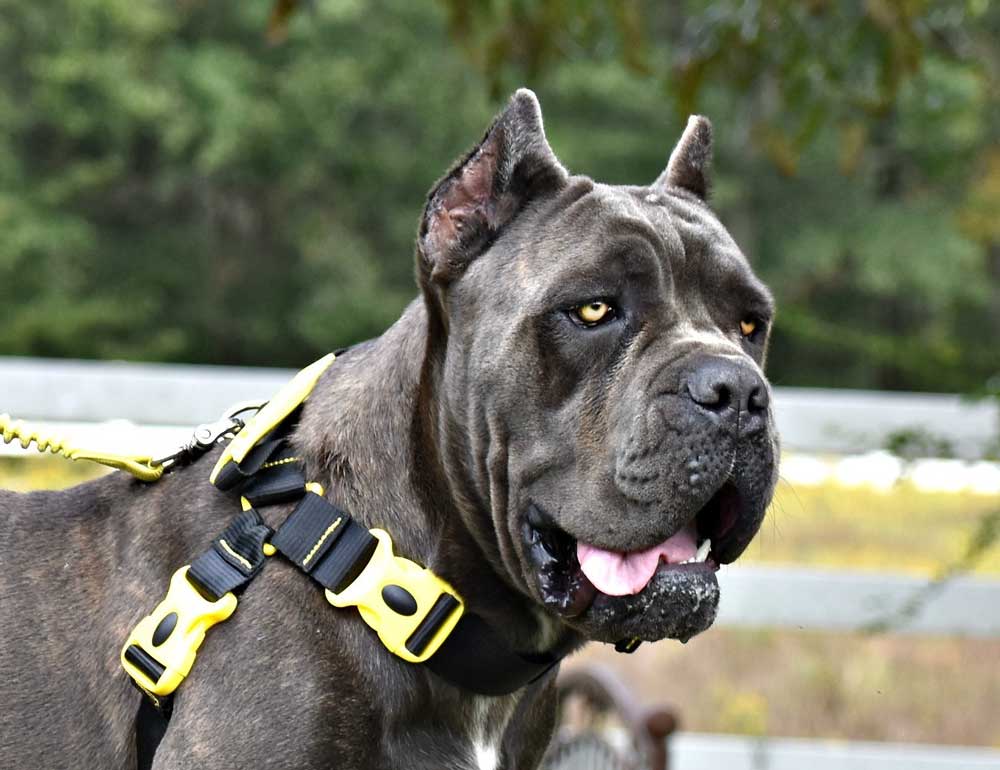
What distinguishes the grey brindle coat color in Cane Corsos? The grey brindle coat color in Cane Corsos is a unique and striking combination of grey and brindle patterns. This color variation is caused by a recessive dilute gene that affects the production of eumelanin, resulting in a diluted grey color. The brindle patterns overlay the grey base color, creating a stunning and distinctive appearance.
If there is an overwhelming light color, that color is called reverse grey brindle.
Regarding breed history, the grey brindle coat color has been present in Cane Corsos since the breed’s early origins. They were originally used as hunting dogs for their tracking abilities. Over time, they’ve gained popularity as loyal companions and versatile working dogs.
Chestnut brindle
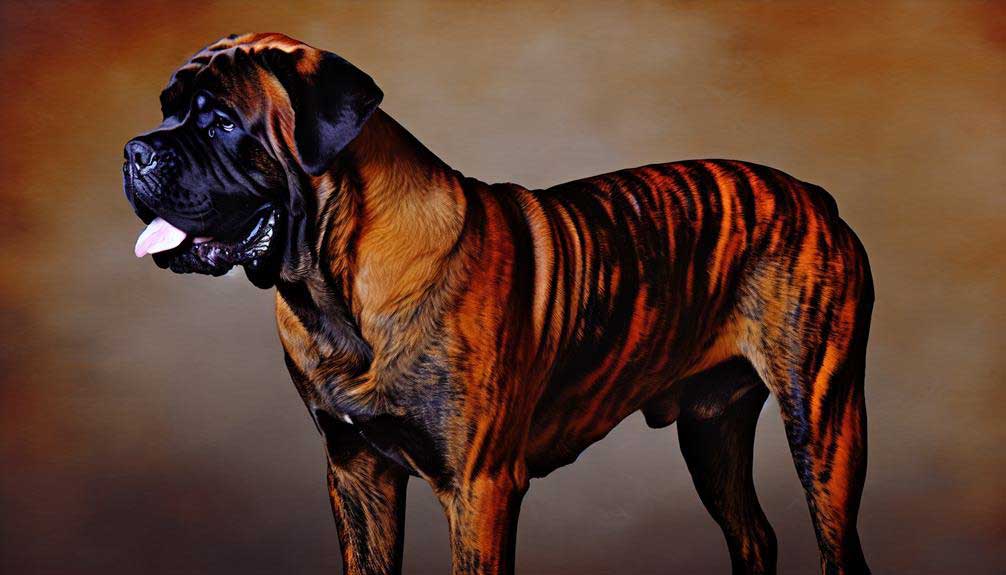
The chestnut brindle is a coat variation that results from specific genetic factors. It is red with black brindle stripes.
Blue
There is debate about the existence of the blue Cane Corso, with some breeders advertising blue Corso puppies for sale. However, the confusion arises from the breed standards referring to the Cane Corso’s diluted black pigment as grey instead of blue. Therefore, a blue Cane Corso is simply a grey Corso with a different name. A recessive mutation in the MLPH gene produces the grey coat coloration.
Formentino
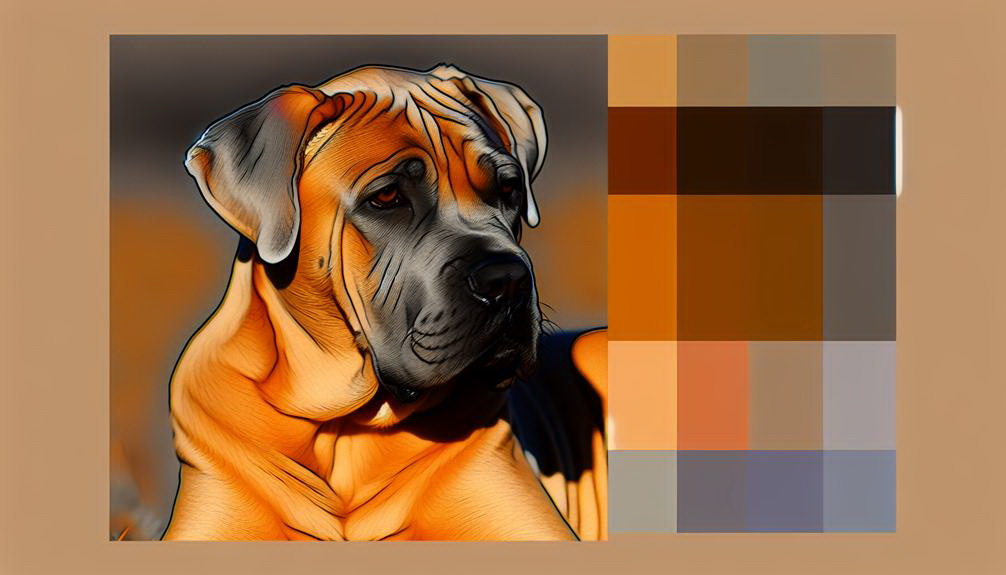
Formentino is a unique coat color found in the Cane Corso breed. “formentino” is derived from the Italian word “formento,” which means fermented wheat. This describes the color of the coat, which is a washed-out fawn with a gray or blue nose and blue mask.
The formentino Cane Corso stands out from other Cane Corsos due to its distinctive appearance. They often have clear-colored or very light blue eyes, giving them a striking and beautiful look. Some breeders have even attempted to pass them off as a separate breed due to their distinct coloring.
It is important to note that the formentino color is officially recognized in the breed standards.
The formentino color is produced by a recessive mutation in the melanophilin (MLPH) gene, which is responsible for the diluted black pigment..
The main difference between formentino and fawn or red is the color of the mask. Formentino dog has a blue mask, and Fawn has black mask.
Chocolate
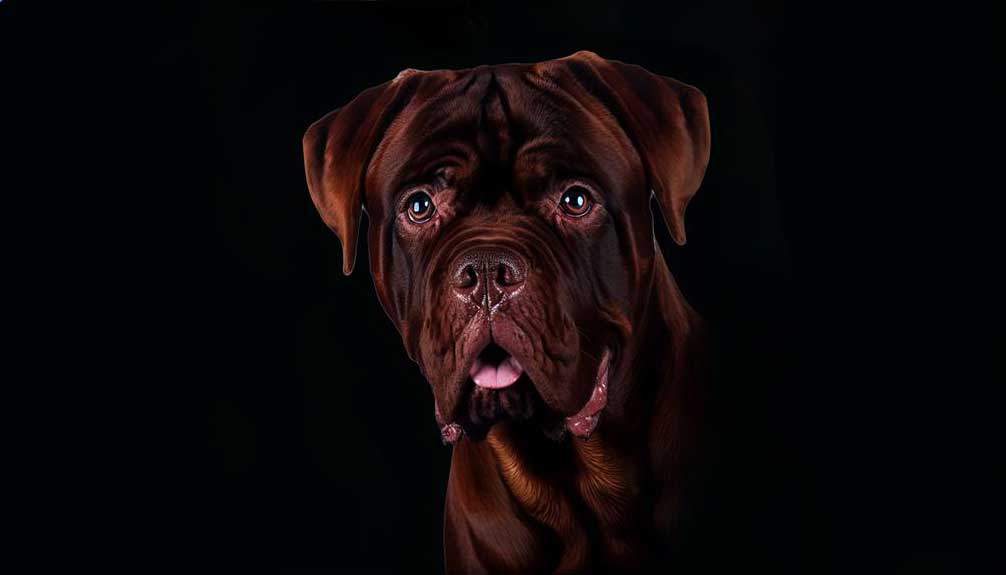
The coat color variation known as chocolate in Cane Corsos results from specific genetic factors that contribute to a rich, dark brown hue in their coat. Chocolate color corsos are also known as liver color, and they have an absolute lack of dark pigment around their eyes, nose, and gums. This color variation is not accepted by both the AKC and FCI. Dark chocolate color is not in the cane corso gene nor pure breed corsos.
Liver color
Most of the time, the liver is in the same bag as chocolate ( light), also known as liver or chocolate, but its a lighter version of chocolate color. It is not a standard color, either.
Isabella
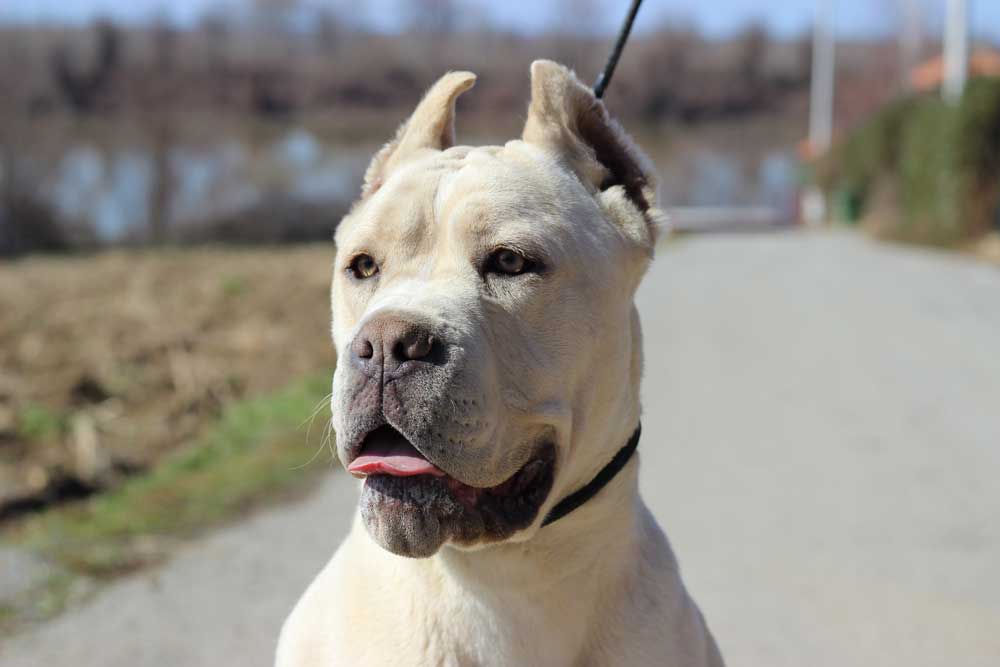
Isabella is a dilute form of black and a recognized color variation in Cane Corsos. The isabella coat is unique and intriguing, setting it apart from other colors in the breed. The genetic formula for isabella is Ay-B-ddEm-K-. This genetic combination results in a coat color that’s lighter and softer in appearance compared to black.
Historically, the isabella color has had significant importance in the Cane Corso breed. It’s believed that Isabella Corsos were used as hunting dogs due to their ability to track blood. This color variation has been present since the 3rd or 4th century and has been valued for its distinct and eye-catching appearance.
When comparing isabella to the fawn color, there are noticeable differences. Isabella Corsos have a dilute black coat, while fawn Corsos have a yellow-colored coat resembling sand or parchment. Isabella color is missing mask, and fawn color cane corsos have a black mask. Isabella is in another breed known as lilac.
Straw or white
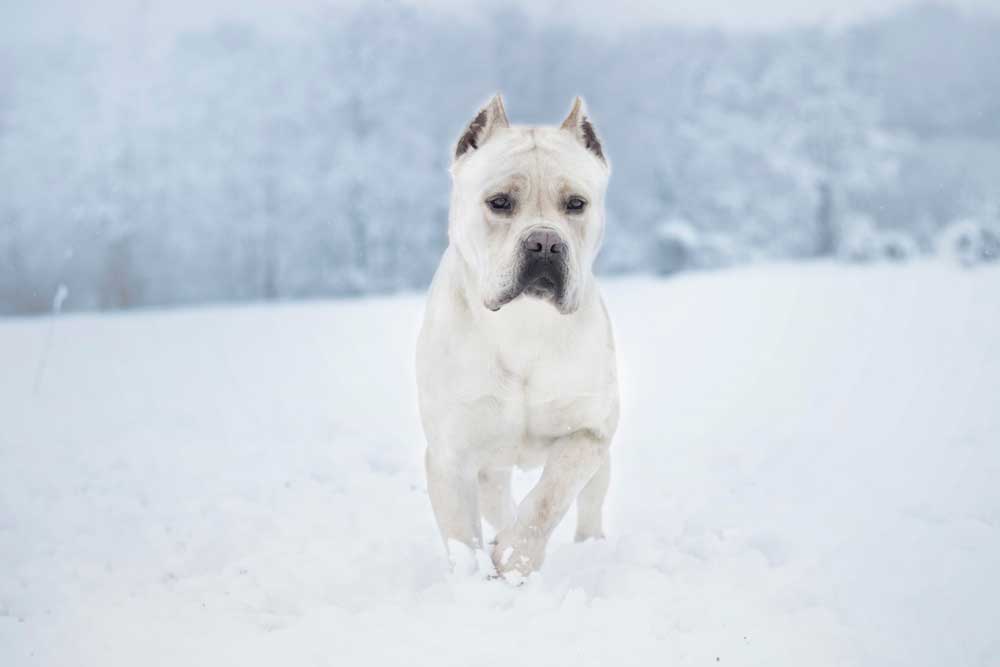
Straw or white isn’t an accepted color variation in the Cane Corso breed standard. Here are five key points to consider about straw or white in Cane Corsos:
- Cream Variations: While straw or white may resemble a cream variation, it’s important to note that cream isn’t an accepted color in the breed standard either because of lack of the mask.
- Albino Concerns: Straw or white coat colors can sometimes be associated with albinism, a genetic condition that affects pigment production. Albino individuals lack melanin, which gives skin, hair, and eyes color. It’s important to be aware of potential health concerns and genetic factors associated with albinism in Cane Corsos, not straws. Straws are not albino!
- Health: Cane corso of these colors are totally healthy. This color is not in standard only because of the lack of a mask.
- Genetic Factors:this color is produced by a recessive gene and, therefore, very rare ( both parents need to be carriers)
- Breed Standard: This is not a standard color, but since it is the rarest color, this color is very popular.
Black and tan color
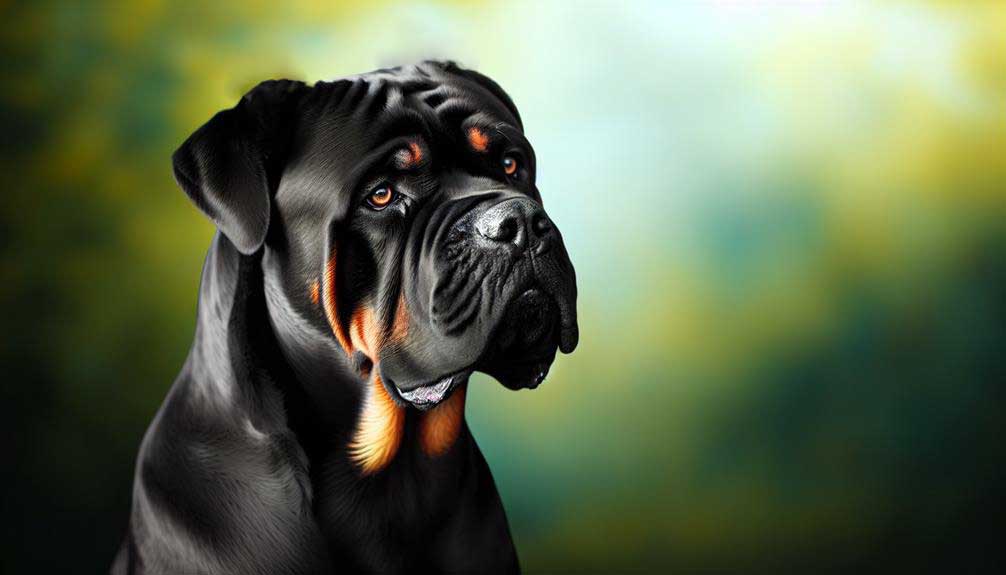
The Cane Corso breed standard doesn’t recognize the black and tan color variation, which departs from the previously discussed colors. Despite not being accepted in the standard, black and tan Cane Corsos do exist.
Black and tan genetics in Cane Corsos involve the presence of the atatB-D-Em-kk alleles. This combination results in a black coat with tan points on the muzzle, eyebrows, chest, legs, and vent area. The distinct contrast between the black and tan creates a striking appearance.
While black and tan aren’t recognized in Cane Corsos, it’s a common color in other dog breeds. Breeds such as Doberman Pinschers, Rottweilers, and German Shepherds can exhibit this color variation. However, it’s important to note that black and tan in Cane Corsos shouldn’t be confused with black brindle. Black brindles have a base color of red or brown with black tiger stripes, while black and tan Corsos have solid black coats with tan points.
The history of black and tan Cane Corsos isn’t well-documented. It’s believed that these dogs may have originated from breeding programs that aimed to introduce the black and tan coloration into the breed. However, due to the lack of recognition in the breed standard, black and tan Cane Corsos are considered non-standard and aren’t eligible to compete in conformation shows.
Blue and tan color
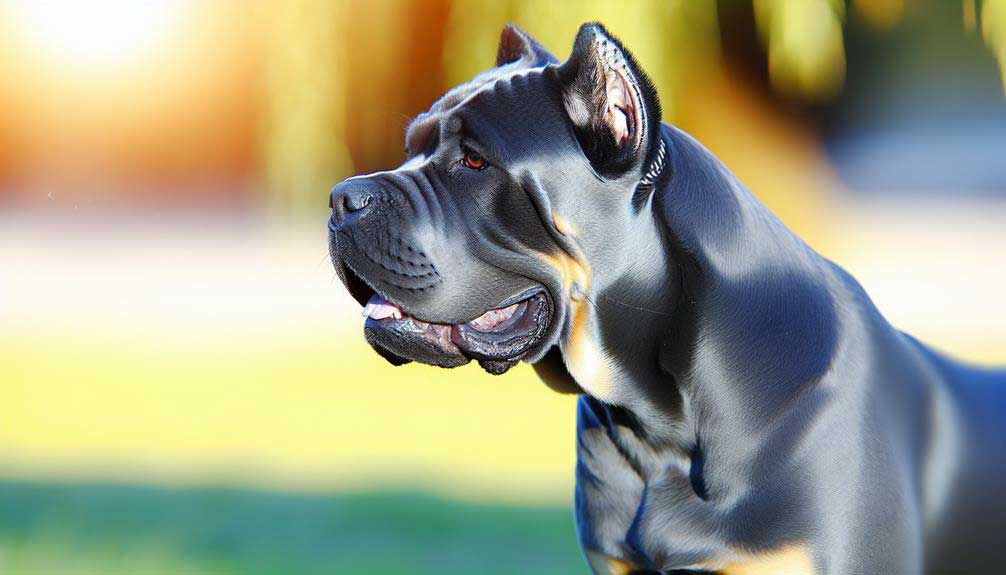
The blue and tan color variation isn’t recognized in the Cane Corso breed standard, but it’s a phenomenon that some individuals may exhibit. Here are some key points about blue and tan in Cane Corsos:
- Blue and tan genetics: The blue color in Cane Corsos results from a dilution gene that affects the production of eumelanin. The presence of the A locus gene determines the tan color. Combining these two genes results in the blue and tan coat variation.
- Blue and tan coat variations: Blue and tan Corsos have a bluish-gray base coat with tan markings on their eyebrows, cheeks, chest, legs, and under the tail. The tan markings can range in shade from light tan to a deeper, reddish hue.
- Blue and tan in other dog breeds: Blue and tan coat variations can also be found in other dog breeds such as Doberman Pinschers and Yorkshire Terriers. However, it’s important to note that the specific genetics and coat patterns may differ between breeds.
- Blue and tan vs blue brindle: Blue and tan Corsos shouldn’t be confused with blue brindle Corsos. Blue brindle Corsos have a base coat of blue with brindle stripes, while blue and tan Corsos have tan markings instead of brindle.
- Blue and tan Corso temperament: The color of their coat has no bearing on how they behave. They’re known for being loyal, protective, and intelligent, just like other Cane Corsos.
While blue and tan Corsos may not conform to the breed standard, they still possess the same desirable traits and characteristics as other Cane Corsos. The blue and tan coat variation adds a unique and visually striking element to these already impressive dogs.
Seal cane corso color
The seal cane corso color is a stunning and distinct variation found in the breed. This unique color is characterized by a rich, dark coat that appears black at first glance but upon closer inspection, reveals a warm undertone of seal brown. Enthusiasts who value the seal cane corso’s striking appearance and uniqueness highly desire it.
The most common cane corso colors
The most common coat color in Cane Corso dogs is black, and when two black parents are crossed, approximately 71.6% of the offspring exhibit a black coat, while 28.4% display other colors.
In the case of crossing two black brindle parents, only 39.5% of the offspring are black brindles, 25.7% are brindles, and 34.8% exhibit other colors.
When two brindle parents are crossed, the resulting offspring consist of 59.4% brindles and 40.6% with other colors. Crossing two fawn parents leads to 84.5% of the offspring having a fawn coat, while 15.5% display other colors .
Similarly, crossing two grey parents results in 76.7% grey offspring and 23.3% with other colors. For grey brindle parents, the segregation produces 50.9% grey brindle offspring and 49.1% with other colors.
The rarest cane corso color
Among the cane corso colors, the rarest are liver, Isabella, and straw. In recent times straw color is becoming more and more popular.
Does the color affect the health?
The color of a Cane Corso’s coat doesn’t directly impact the dog’s health. While certain color variations may be associated with specific genetic disorders, these disorders aren’t directly caused by the color itself. For example, some rare coat colors, such as liver or blue, may be linked to a higher risk of certain health conditions. However, it’s important to note that color isn’t the sole determining factor for these disorders. Other genetic and environmental factors also play a role.
Additionally, the impact of color on temperament isn’t significant. Rather than the color of their coat, a Cane Corso’s personality and behavior depend on a combination of genetic and environmental factors. It’s worth noting that there may be color preferences among Cane Corso owners, but these preferences are subjective and don’t affect the overall health or well-being of the dog.
Regarding health risks associated with rare coat colors, breeders and owners must be aware of potential genetic disorders that may be more common in specific color variations. Responsible breeding practices and genetic testing can help mitigate these risks and ensure the breed’s overall health.
Furthermore, coat color plays a role in Cane Corso breed standards. Certain colors may be preferred or required in conformation shows and breeding programs. However, it’s important to prioritize the health and well-being of the dog above all else. Breed standards shouldn’t prioritize certain colors at the expense of the dog’s health or increase the risk of genetic disorders.
Cane corso eyes colors
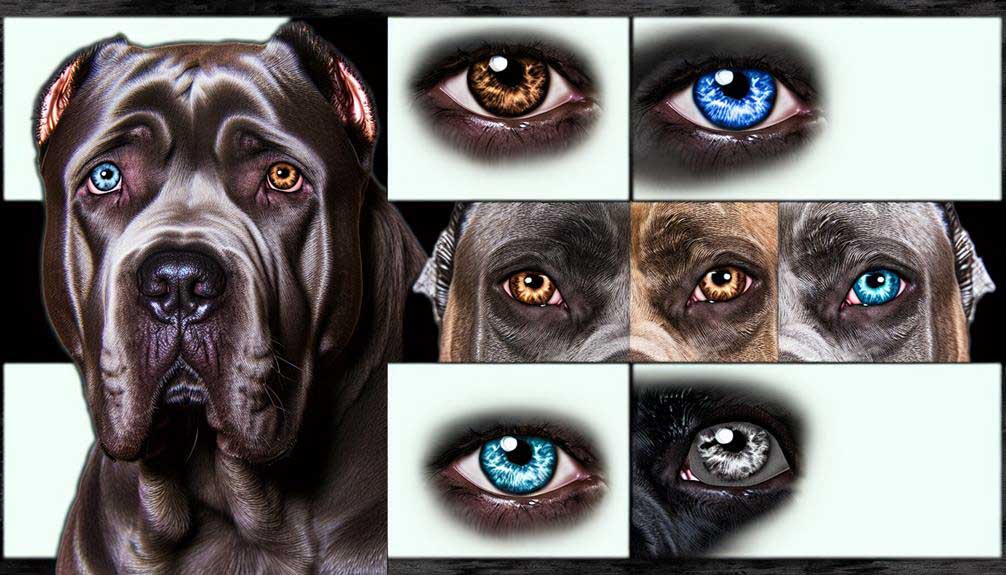
The color of a Cane Corso’s coat may also impact the color of their eyes. The eye color of a Cane Corso can vary depending on their coat color genetics and the historical significance of different coat colors.
Here are some key points about Cane Corso eye colors:
- Coat color genetics: The genes that determine a Cane Corso’s coat color can also influence the color of their eyes. For example, black Corsos often have brown eyes, while gray Corsos can have a range of eye colors, including amber and hazel.
- Color variations in cane corsos: Cane Corsos can have a variety of eye colors, including brown, amber, hazel, and even blue. These variations add to the uniqueness and beauty of the breed.
- Color preferences in breed standards: The breed standards for Cane Corsos don’t specify a preferred eye color. This allows for individual variation and ensures that the focus remains on the overall health and temperament of the dog.
- Historical significance of coat colors: Certain coat colors, such as black and gray, have historical significance in the Cane Corso breed. These colors were often favored for their intimidating appearance and hunting abilities.
- Personal preferences: While eye color may not be a significant factor when selecting a Cane Corso, some individuals may have personal preferences. It’s essential to remember that eye color doesn’t affect the dog’s overall health or temperament.
